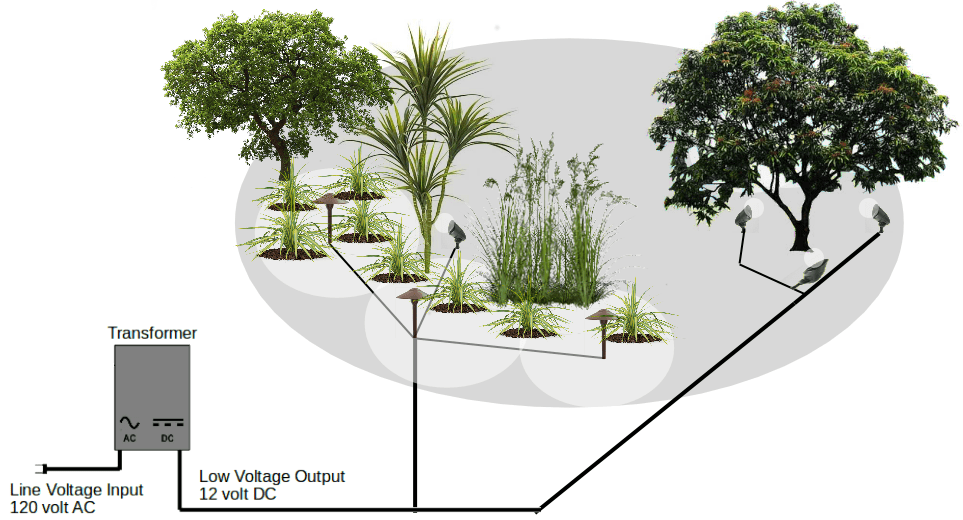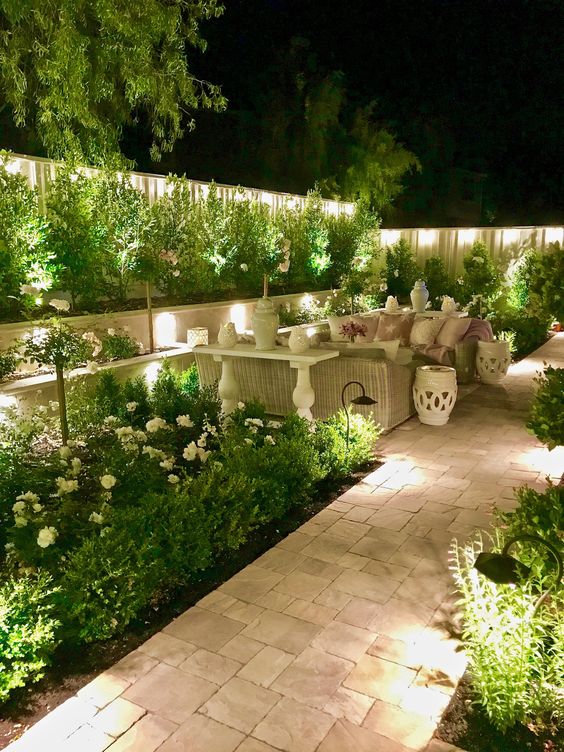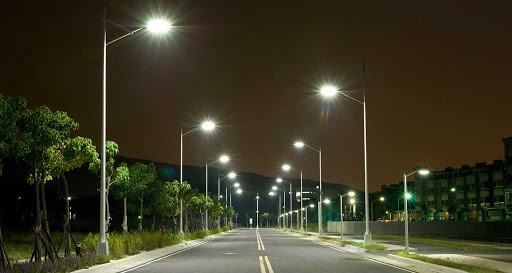What is Low Voltage Landscape Lighting?
Low Voltage lighting is a lighting system that uses 12/24 Volts to operate. An additional transformer is required to decrease the regular line voltage of 120/240V to 12/24V. The transformer is usually built into the fixture, and if not, a remote transformer is used; you have to ensure that the wattage rating is equal to or greater than the lighting system’s combined wattage rating.
These are popular choices for Landscape spotlights, LED Post Lights, LED Bollard Lights, etc. You can find many LED fixtures for low voltages, and they are more versatile than line-voltage lights. Low-voltage lights are best for landscape lighting, which has restricted access.
The low-voltage requirement greatly pleases energy-conscious people, and rightly so. Due to their efficiency, Low-Voltage lights are becoming the preferred choice for outdoor use. You can find these in many areas of interest, such as safety, commercial, and outdoor landscape decoration.
Energy efficiency is not the only criterion for selecting landscape lights. Other factors also play a role.

What is Line Voltage Landscape Lighting?
A line voltage lighting is a plug-and-play landscape lighting system that runs on the standard line voltage of 120 Volts. You must only connect it to the ordinary supply socket, which starts running. So, unlike Low Voltage Lights, you do not need a transformer in a circuit.
The power cables for 120V line voltage lights must be safely buried 2 feet under the ground. It is better to use plastic conduits and sealed junction boxes at the end. These heavy-duty line voltage lights work best in large landscapes or residential places with lots of greenery. They are much brighter, but modern low-voltage lights also produce somewhat similar lumens.
It is a popular design choice for outdoor, security, and commercial lighting as they require less purchase and are easy to set up and maintain. Line voltage lighting is more common in landscape lighting, and it can cover a large area, guaranteeing proper wiring is done.
Their applications are numerous, and despite their large electricity consumption, the line voltage lights have their significance.
What’s the Difference Between Low Voltage and Line Voltage Landscape Lighting?
You can choose a lighting system based on the various aspects of line and low voltage landscape lights.
Both are popular choices for landscape lighting, but the final decision depends upon the following factors in general. By going through these, you can decide which lighting system is best suited for your project.
Investment Cost
Low-voltage lights require a larger initial investment compared to Line-Voltage lights. This is due to the additional circuitry (transformer) present in the fixture of low-voltage landscape lighting systems.
Line-voltage lights are initially cheaper, but the operating cost is larger unless installed in low-use areas. A line-voltage landscape system also has lesser installation costs and less expensive dimmers than low-voltage lights.
Light Output Quality
The higher voltage bulbs used in line voltage systems tend to produce warmer and more diffused light output. On the other hand, low-voltage lamps give off more natural light and directed light beams.
Low-voltage LED bulbs produce superior light quality as they scatter less light and offer a higher degree of optical control. They are primarily used in applications that need to be enhanced aesthetically. You can have a wide range of color temperatures and various beam spreads, such as floodlights and spotlights, which is not the case with line-voltage lights, which have limited options.
Energy Efficiency in Both Cases
A 50-watt low-voltage LED light consumes approximately the same wattage as a line-voltage lamp of similar power, but the low-voltage bulbs produce far more lumens than the standard line-voltage one.
Modern LED technology has dramatically enhanced low voltage LEDs’ capabilities, and you can find these to be brighter than before. They are also replacing low voltage halogens-MR16 lamps due to their better efficiency.
Regular low-voltage lights have a life of 6000+ hours compared to line-voltage bulbs, which have a life of only 800 hours (approximately). Low-voltage lights also produce less heat, which makes them more energy efficient.
Safety
Low-voltage landscape lighting is safer as it operates on a low voltage of 12/24V. This safety factor makes low voltage LEDs more popular in outdoor projects such as playgrounds and schools where children’s safety is a significant concern and a chance of kids or people coming in contact with a wire. You can quickly and safely install these if professional electricians are not available.
Line voltage is best suited for outdoor use where safety is not a concern and vast areas need to be lighted.
Cables and Connections
To maintain safety standards, the wires need to be buried at least 18 inches into the ground for line voltage. You can also place the cables inside a conduit to avoid hazards. Always use high-quality wires and connections that are water—and shock-proof.
Low voltage is safer and does not require the wires to be buried deep under the ground. If necessary, you can place the low-voltage wires only a few inches in the ground, which would be sufficient for any application.
Relocation Of The Systems
The low-voltage lighting system can be easily relocated because it is not permanent like a line-voltage system. Moreover, you can easily add another fixture to the low-voltage system, provided that the transformer has the capability to handle another fixture.
Voltage Drop
Voltage drop is the decrease in the voltage along the circuit consisting of lighting fixtures. It occurs in a low-voltage lighting system as electricity is lost in transmission. This is because the voltage decreases with the cable’s length, and the fixtures receive less power for the optimum output.
To fix this, you have to place a transformer closer to Low-Voltage landscape lights and avoid the daisy-line configuration, as in this configuration, the first fixture will receive most of the power compared to the fixtures to follow.
This is not the case in line voltage, as sufficient power is available for the fixtures to run correctly.
In low-voltage lighting, it is advisable to split the wire runs for more evenly distributed power across all the fixtures. Moreover, transformers can handle the load of a certain number of fixtures. Decide which transformer is best by first calculating the total wattage for all the fixtures you want to light up.
Installation
Low-voltage lights require a transformer to step down the regular voltage supply of 120/227V to 12/24V. Some fixtures come with a built-in transformer, while others require a separate transformer near the circuit. This is hazard-free and safer to install.
On the other hand, line voltage lighting does not require a transformer to step down the voltage, making it easier to install. However, line voltage does require the supervision of a professional electrician because it deals with a high voltage of 120 volts.
Maintenance Challenges
You may require electricians to determine where the transformer should be placed for large, low-voltage landscape projects. This is not the case for line-voltage lights because no transformer is used in the system.
In the long run, low-voltage lights are more economical due to lower electricity consumption. Low-voltage LED lights are also longer-lasting than other lights, saving resources in repair and maintenance costs.
Applications
Before choosing the system, you must first understand the requirements of your project. Both line and low-voltage systems perform best in specific applications.
- Low-voltage Lighting is popularly used in projects that demand a customized, stunning outlook. The user can control these lights, making them suitable for designing aesthetic projects using low-voltage LED bollards lights, underwater spotlights, LED fountain lights, etc. These lights are primarily used in residential and commercial areas such as pathways, parks and playgrounds, display lighting applications, etc.

- Line voltage lighting is mainly used in applications that require long wire runs, such as landscapes, architecture, streets, etc. It is also used in commercial and public areas where a large region needs to be illuminated by a few bright fixtures. Line voltage is often seen in security applications where high illumination is required for a large area.

Conclusion
Both line-voltage and low-voltage lighting systems have pros and cons, which determine their applications. Before opting for a system, learn about each system’s investment cost, installation procedure, output quality, lamp life, long-term operation, and safety concerns. Knowing the differences will help you choose a better landscape lighting system for your project.
